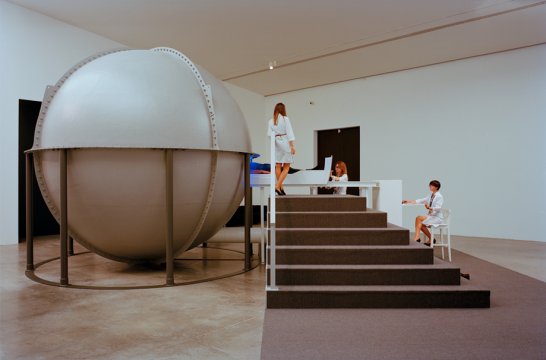Images from 'Seven Practical Experiments' workshop as part of Sum total of all the actions at Rogue artists studios. 1: Feldenkrais - See notes on the inwardly generated image (by deformation of the eyeball) 2. Anomalous perception scale Spontaneous sensations 3: Action intention paradox [See developmental notes] Alien hand 4: Concerning the inwardly generated image [See notes on Ganzfeld variation 1] 5: You are the object of your own observation [See notes on the mirror gaze experiment] 6: You are the object of your own observation. Mirror Gaze experiments in near darkness. 6: Perception without object [The perception of spatial relationships in respect to the orientation of one's body despite distracting information] See notes on Ganzfeld variation 2 7. The permanent possibility of experience. An based on the experiments of Ernst Mach [Notes to come]
Tag: participatory
Sum Total Of All The Actions 5
Carsten Holler / Olafur Eliasson
Carsten Holler is a key example within this study, often re- appropriating science for the purposes of art. Staging ‘Quasi-scientific’ experiments (Windsor, 2018) which transform the gallery into a laboratory. Often disorientating the viewer, or more appropriately, the participant. As well as the large-scale installations smaller performative works such as ‘Kit for Exploration of the Self’ (Carsten. Holler, 1995) take the form of durational perception changing instruments such as ‘Upside Down Glasses’ (Carsten Holler, 1994-2018). These both directly re-appropriate methods from experimental psychology (Stratton, 1896). Many of the works require the participant to travel through them or offer the opportunity to make decisions of which there are no return or unknown outcomes, further reinforcing this active notion of experience as
Labyrinth Psychotica
Labyrinth Psychotica is an artistic research project that aims to simulate the experience of psychosis. It uses multisensory [tactile and sonic] elements in combination with the maze environment, to create a fully immersive experience. The maze mechanism also serves as a metaphor for attempting to get inside the mind of another. The investigation aimed to not only portray an experience of psychosis but one that was ‘artistic’. It further asks if such an endeavour could prove ‘useful’. Though I can only speak from my experience of the work [1], it did seem effective in conveying elements of this experience, such as; loss of personal boundaries, and blurred borders between the body and space. Another element which resonates with Action Lab is the
Making Immersive Experiences
“ What do new immersive technologies, such as augmented reality, virtual reality and artificial intelligence, offer storytellers and makers? And do they change the stories we choose to tell audiences? Two internationally renowned digital storytellers and makers present their latest creative projects and help us to find answers to these questions.” Notes from 'Making Immersive Experiences 1: Lance Weiler, Storytelling Lab, Columbia University + Chris Mullany, Marshmallow Laser Feast' Organised by Immersion Research Group, Manchester Metropolitan University Immersive storytelling is not something I have really ever thought about in relation to my work, however, I find the ideas discussed resonated strongly with my own practice and collaborations I have been part of. While listening to the speakers I realised I have taken part in
Fish-brain-machine / Radiona workshop
After constructing the Fish-brain-machine PCB circuits we spent some time experimenting and describing the hallucinogenic visuals created by the stroboscopic light. The ping pong balls over the eyes diffuse the LED light, making for a more intense effect - and enabling use with eyes open. Here they describe some of the effects including seeing colours and 'a strange experience' of seeing with only one eye - I get this exact same feeling when using it. It is also hard to know if your eyes are open or closed. [See also Re-mapping the senses workshop ] https://www.youtube.com/watch?v=Lwne5xICLkI
Spontaneous sensations
Possibly one of the simplest experiments possible to conduct, requiring no special equipment. Simply stare at your hand for 5 mins. The experiment is described in the paper “the tickly homunculus and the origins of spontaneous sensations arising on the hands" in which you focus on your hand while staring at it (convergent focusing) or divergent focusing (staring at red marker next to the hand you are focussing on) for just 10 seconds and report the sensations. Here are the outcomes superimposed from 8 participants. In this experiment, many of the bemused participants described a tingling where the hand made contact with the table. They were bemused because I did this experiment in the context of our methods and methodologies discussion group - where I was
Radiona workshop, Zagreb
I'm doing a workshop related to my research, perceptual illusions and altering perception through experiments, Clay hand illusion and other activities based on sound and light and taste, at Radiona Zagreb, 21-22/04/2018 https://radiona.org/ check out the web Re-mapping the senses workshop page and resources here...
James Turrel – Light Reignfall
[vimeo 75419053 w=640 h=360] James Turrell's Light Reignfall @LACMA - Andrew van Baal James Turrell's Light Reignfall Light Reignfall is a work from his series of perceptual cells, inside the participant is exposed to a uniform homogenous field of modulated light. A combination of sensory overstimulation, yet deprived of recognisable forms or space, hallucinatory effects are experienced. “Assisted by an attendant, an individual viewer enters a spherical chamber on a sliding bed. A program of saturated light (operated by a technician) surrounds the viewer for twelve minutes, allowing the visitor to experience the intense, multi-dimensional power of light and the complex seeing instrument of the human eye.” "James Turrell (b. 1943, Los Angeles), a key artist in the Southern California Light and Space movement



